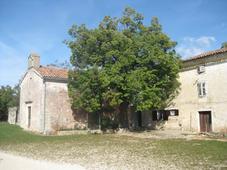to enlarge


or choose the place
from the menu below
 Rome |
 Byzantium |
 Venice |
 Vienna |
 Brioni |
 Smrikve |
 |
 |
Just on the outskirts of Pazin on the road that goes towards Beram there is another nice property worth visiting. Camus property is located on Gortanov brijeg just few kilometers far away from Pazin. A white road will lead you to the hilltop where an old monastery was set up by Benedictine Monks probably in the 7th and 8th century.
 It is a very nice place
that still conserve most of its original architecture. A small Church of St.Michael is located in the middle
of the property with an old linden tree. Over its long history has changed many inhabitants and in a letter written by the
pope Alexander III to the Bishops of Porec in 1177 recall the property. Bisohps of Porec received the property from Aquileia
Patriarch in 1102 and in turn they got it from Ulrich II Weimar. It is also known that in the 13th century the Bishop of Pican
lived in this property.
It is a very nice place
that still conserve most of its original architecture. A small Church of St.Michael is located in the middle
of the property with an old linden tree. Over its long history has changed many inhabitants and in a letter written by the
pope Alexander III to the Bishops of Porec in 1177 recall the property. Bisohps of Porec received the property from Aquileia
Patriarch in 1102 and in turn they got it from Ulrich II Weimar. It is also known that in the 13th century the Bishop of Pican
lived in this property.
 Later on various owners
till the family from which the property is known still today were: Enrico De Pisino (1264), Angelino De Pisino (1282), Brestain
or Eberstein (1428), Giovanni Zehorner (mid 15th century), Paulin Monks (1452), Porec Bishops (1469), Andrea di Chersano (1488),
Giorgio Krofftzhover (1573), Giovanni Toltschey (1630), Carlo Cavalieri (1719), Giuseppe Zaccaria (1753), Camus family (18th
century).
Later on various owners
till the family from which the property is known still today were: Enrico De Pisino (1264), Angelino De Pisino (1282), Brestain
or Eberstein (1428), Giovanni Zehorner (mid 15th century), Paulin Monks (1452), Porec Bishops (1469), Andrea di Chersano (1488),
Giorgio Krofftzhover (1573), Giovanni Toltschey (1630), Carlo Cavalieri (1719), Giuseppe Zaccaria (1753), Camus family (18th
century).
PAZIN – HISTORICAL OVERVIEW
Pazin is an old Istrian town but younger than many other Istrian towns and villages. It do not dates back into prehistoric times and is about thousands years old town.
Nearby Pazin there is an older village named Old Pazin on a 358 meters hilltop that was a prehistoric settlement. In 1983, Pazin celebrated its 1000 years history. Probably is a little bit older because it is known that in 929 Ugo of Provence, king of Italy, donated to the church of Porec “Castrum Pisinum”.
Later on under German rule Pazin will be named for centuries Mitterburg. In 983, the donation was confirmed to the Bishop Andrea by the Emperor Ottone II. At the time the Old Pazin was much more important settlement than the Pazin we know today.
The documents from 996 and 1012 proves that the owners of Pazin were the Aquileia Patriarchs. From 1060 the area of Pazin was under Porec’s Bishops dominion. At the time the Bishops used to nominate the lawyers and administrators for their dominions. The Bishops of Porec named as their lawyer and administrator Mainhard von Schwarzenburg.
In 1102 Ulrich II of Weimar donated all of his possessions in Istria to the Aquileia Patriarchs and a small village, Crnograd, near Lupoglav was donated to the parents or grandparents of Mainhard. Crnograd is a Croatian word that means black town in English or Schwarzenburg in German. It is not clear how Mainhard von Schwarzenburg from Bishops’ lawyer and administrator became the owner of Pazin but is known that in 1158 he founded the County of Istria that was later on also named County of Pazin and became the ruler of the area around Pazin. Officially Bishops of Porec transferred the Castle of Pazin to Mainhard in 1175.
After his death the successor was his daughter Matilde that married Enghelberto III, Count of Gorizia. Matilde became countesses of Pazin in 1220. County of Pazin was independent part of Marquisate of Istria and was part of County of Gorizia.
The successors and rulers of Pazin after the death of Mainhard were: Matilde and Enghelberto III (1185), Mainhard II (1220), Alberto II and Mainhard IV (1258), Alberto II and Enrico II (1295), Enrico II (1304), Giovanni Enrico (1323), Alberto IV, Mainhard VII and Enrico III (1338) and Alberto IV from 1342 until 1374.
In 1342 the County of Gorizia and Pazin was divided among brothers and Alberto IV became the ruler of County of Pazin that was named at that time County of Istria. All the mentioned successors and rulers, excluded Alberto IV, were also the Counts of Gorizia.